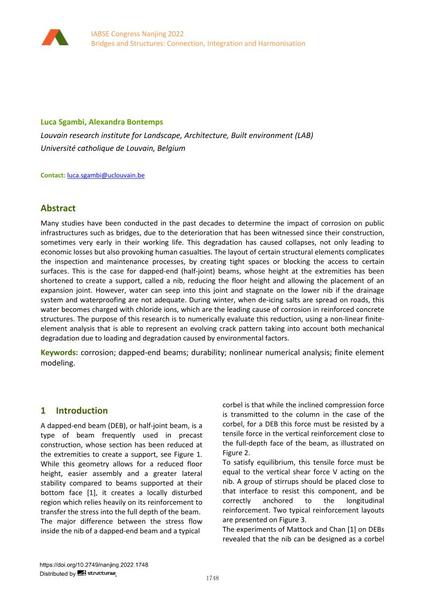Effects of Corrosion on the Capacity of the Nib of Reinforced Concrete Dapped-End Beams

|
|
|||||||||||
Bibliographic Details
| Author(s): |
Luca Sgambi
(Louvain research institute for Landscape, Architecture, Built environment (LAB) Université catholique de Louvain, Belgium)
Alexandra Bontemps (Louvain research institute for Landscape, Architecture, Built environment (LAB) Université catholique de Louvain, Belgium) |
||||
|---|---|---|---|---|---|
| Medium: | conference paper | ||||
| Language(s): | English | ||||
| Conference: | IABSE Congress: Bridges and Structures: Connection, Integration and Harmonisation, Nanjing, People's Republic of China, 21-23 September 2022 | ||||
| Published in: | IABSE Congress Nanjing 2022 | ||||
|
|||||
| Page(s): | 1748-1755 | ||||
| Total no. of pages: | 8 | ||||
| DOI: | 10.2749/nanjing.2022.1748 | ||||
| Abstract: |
Many studies have been conducted in the past decades to determine the impact of corrosion on public infrastructures such as bridges, due to the deterioration that has been witnessed since their construction, sometimes very early in their working life. This degradation has caused collapses, not only leading to economic losses but also provoking human casualties. The layout of certain structural elements complicates the inspection and maintenance processes, by creating tight spaces or blocking the access to certain surfaces. This is the case for dapped-end (half-joint) beams, whose height at the extremities has been shortened to create a support, called a nib, reducing the floor height and allowing the placement of an expansion joint. However, water can seep into this joint and stagnate on the lower nib if the drainage system and waterproofing are not adequate. During winter, when de-icing salts are spread on roads, this water becomes charged with chloride ions, which are the leading cause of corrosion in reinforced concrete structures. The purpose of this research is to numerically evaluate this reduction, using a non-linear finite- element analysis that is able to represent an evolving crack pattern taking into account both mechanical degradation due to loading and degradation caused by environmental factors. |
||||
| Keywords: |
durability corrosion finite element modeling (FEM) dapped-end beams nonlinear numerical analysis
|
||||
| Copyright: | © 2022 International Association for Bridge and Structural Engineering (IABSE) | ||||
| License: | This creative work is copyrighted material and may not be used without explicit approval by the author and/or copyright owner. |
||||
